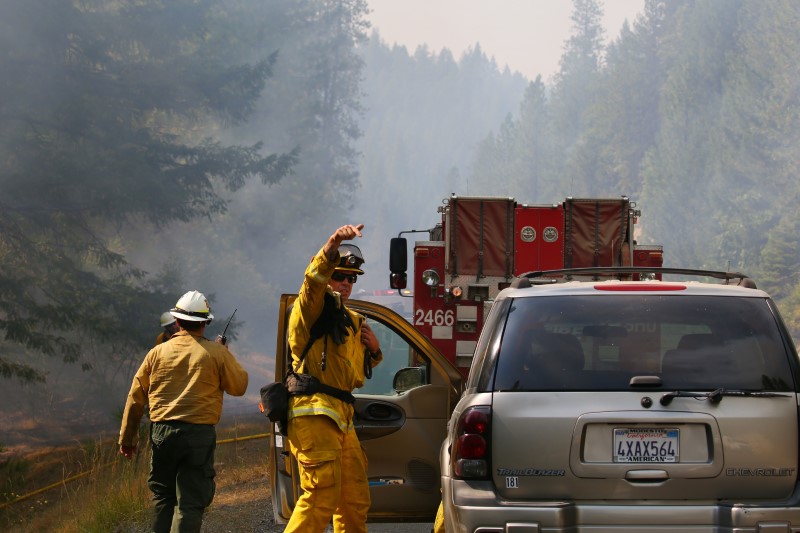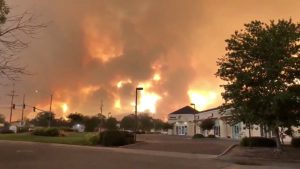
By Alex Dobuzinskis
LOS ANGELES (Reuters) – Hundreds of firefighters were building barriers and constructing containment lines early on Friday to slow an approaching wildfire threatening to torch thousands of homes in a lakeside community southeast of Los Angeles.

A plane dumps fire retardant over the Holy Fire as it spreads in Lake Elsinore, California, the U.S. August 8, 2018, in this still image taken from a video obtained from social media. Lake Elsinore City Hall/via REUTERS
More than 21,000 people have been evacuated in and around Lake Elsinore where furious flames and billowing smoke rose into the sky at the edge of the city of 60,000 as the blaze, dubbed the Holy Fire, burned nearby in the Santa Ana Mountains.
“It feels like a war zone,” Ana Tran told the Los Angeles Times as ash and flame retardant fell on her neighborhood.
The fire, which was five percent contained, was being fueled by dry brush covering steep terrain and stoked by erratic wind gusts during the night, said Thanh Nguyen, a spokesman for the incident said.
“Strong downdrafts is making the fire move aggressively downhill,” said Nguyen, noting that firefighters were working to build barriers and containment lines to protect more than 2,000 homes at risk from the fire.
Three firefighters suffered minor injuries battling the relatively small blaze that consumed more than 10,200 acres (4,128 hectares) since it began on Tuesday, fire officials said.
Governor Jerry Brown declared a state of emergency for the area on Thursday, freeing up additional resources to battle the blaze. Forrest Clark, 51, was charged with setting the fire, the Orange County District Attorney Office said.

A plane flies off after dumping fire retardant over the Holy Fire close to a residential area in Lake Elsinore, California, the U.S. August 8, 2018, in this still image taken from a video obtained from social media. Camille Collins/via REUTERS
The Holy Fire was one of several fires burning in California that have displaced tens of thousands of people. Wildfires across the state and region could be further stoked by strong gusts, low humidity, and hot weather on Friday and Saturday, forecasters warned.
In Northern California, a mechanic helping to fight the Carr Fire burning around Redding was killed in a traffic collision on Thursday, bringing the death toll from that blaze to eight, the California Department of Forestry and Fire Protection (CalFire) said. The 178,000-acre Carr Fire has killed two other firefighters along with three members of one family and has destroyed nearly 1,100 homes. It was 49 percent contained with firefighters struggling in steep terrain to control the blaze, CalFire said.
More than 4,000 firefighters are battling the Mendocino Complex Fire, which has burned 305,200 acres in three counties north of San Francisco, CalFire said.
Two firefighters were injured and 119 homes destroyed by that fire which now ranks as the largest fire on record in the state.
(Reporting by Brendan O’Brien in Milwaukee, Editing by William Maclean)

















